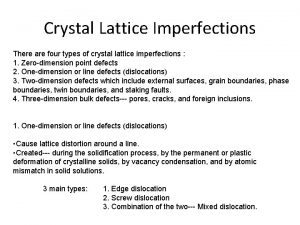SRF Cavity Imperfection Studies Using Advanced Shape Uncertainty

- Slides: 1

SRF Cavity Imperfection Studies Using Advanced Shape Uncertainty Quantification Tools* V. Akcelik, L-Q Lee, Z. Li, C-K Ng, L. Xiao and K. Ko, SLAC Menlo Park, CA 94025, USA Abstract: The deviation of a SRF cavity from the designed shape may have a significant impact on cavity performance and its wakefields with unexpected effects in beam dynamics. Most of these deviations are unknown in the final cavity installation because of the complicated process of fabrication and tuning. It is desirable to quantify these deviations using measurable RF parameters so that one can better predict the cavity performance and implement realistic tolerance criteria on design and manufacturing to improve quality assurance. As part of the DOE Sci. DAC Com. PASS project, SLAC has developed advanced Shape Determination Tools that can recover the real cavity shape from cavity data by solving an inverse problem. The capabilities of these tools and their successful application to identify the cause of the BBU in the CEBAF 12 Ge. V Upgrade will be presented. Motivation Deformation of TDR cavity • SRF cavities real shape differs from original shape due to loose machine tolerance and tuning process for the accelerating mode. • The deformation of the cavity leads to changes in higher order mode frequencies, field distribution and their damping affects, and may result in beam instabilities. Stability threshold • Objective function includes monopole and dipole frequencies, and monopole field values along the cavity axis. • Inversion algorithm successfully reduced the frequency error for the deformed cavity to the noise level. (R/Q) x Qe 8 TESLA cavity measurements 2 nd Dipole Band Dipole mode measurements in a TDR module • Direct measurement of cavity shape is not feasible. • Infer cavity shape from measured rf parameters. Frequency misfits for the ideal and deformed shapes Inverse Problem for Shape Determination • Solve an inverse problem to determine the deformed cavity shape. • Use measured rf parameters such as frequency, external Q and field profile as inputs. Beam Breakup in CEBAF 12 -Ge. V Upgrade • BBU observed at well below the designed beam current. • HOMs with exceptionally high Q measured. • The inversion variables are the shape deviations. HOM coupler Qext of vertical modes for ideal and deformed cavities Field profile of high-Q modes in deformed cavity • Objective function is to minimize weighted least square misfit of the computed and measured response Ideal and deformed cavities • The nonlinear least squares problem is solved using Gauss. Newton method. • Nonlinear optimization algorithm typically converges within a handful of iterations. * Ideal Deformed • Solutions to the inverse problem identified the main cause of BBU: Cavity is 8 mm shorter – subsequently confirmed by measurements. • Fields of the 3 abnormally high Q modes shifted away form the coupler. • Importance of quality control underscored. Work supported by the U. S. DOE ASCR, BES, and HEP Divisions under contract No. DE-AC 02 -76 SF 00515

